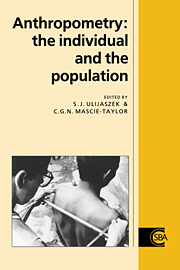Book contents
- Frontmatter
- Contents
- List of contributors
- Preface
- Acknowledgements
- 1 The place of anthropometry in human biology
- 2 Asymmetry and growth
- 3 Intra- and inter-observer error in anthropometric measurement
- 4 Statistical issues in anthropometry
- 5 Statistical constructs of human growth: new growth charts for old
- 6 Growth monitoring and growth cyclicities in developed countries
- 7 Growth monitoring, screening and surveillance in developing countries
- 8 Variability in adult body size: uses in defining the limits of human survival
- 9 Anthropometry and body composition
- 10 Anthropometry and physical performance
- 11 Anthropometry, strength and motor fitness
- 12 Anthropometry in the US armed forces
- Index
1 - The place of anthropometry in human biology
Published online by Cambridge University Press: 19 November 2009
- Frontmatter
- Contents
- List of contributors
- Preface
- Acknowledgements
- 1 The place of anthropometry in human biology
- 2 Asymmetry and growth
- 3 Intra- and inter-observer error in anthropometric measurement
- 4 Statistical issues in anthropometry
- 5 Statistical constructs of human growth: new growth charts for old
- 6 Growth monitoring and growth cyclicities in developed countries
- 7 Growth monitoring, screening and surveillance in developing countries
- 8 Variability in adult body size: uses in defining the limits of human survival
- 9 Anthropometry and body composition
- 10 Anthropometry and physical performance
- 11 Anthropometry, strength and motor fitness
- 12 Anthropometry in the US armed forces
- Index
Summary
The chief point about anthropometries is that any aspect of physiological function depends on the underlying morphology, and the objective way of evaluating and comparing aspects of morphology is measurement. In the human that is anthropometry. The anatomical sciences were long plagued and continue to be beset with a technical problem: descriptive anatomy necessarily leads to comparisons of categories with arbitrary inter-category boundaries. The categorizations therefore tend to be subjective and their artificiality leads to analyses which are typological. However, the human body does not work that way. Most structures vary continuously and their functioning is according to tendencies which are best described by what might be called ‘vectors’. Understanding such vectors must come from analyses of the relationships between measurements of the functions and measurements of the underlying anatomical structures.
All this may seem self-evident, but a surprising amount of anatomy and pathology is still presented in typological terms. The very concepts of ‘normal’ and ‘pathological’ imply that one can determine the boundary and that it has an invariant significance for disease. But the boundary is not fixed. This can be illustrated using as an example the torus palatinus, a benign protuberance on the hard palate of some individuals. One individual does not even know that he or she has a torus palatinus, another individual has one that affects speech, and a third is worried silly that he or she has a cancerous growth of the hard palate. These differences relate in part to the size of the torus.
- Type
- Chapter
- Information
- AnthropometryThe Individual and the Population, pp. 1 - 6Publisher: Cambridge University PressPrint publication year: 1994
- 6
- Cited by

